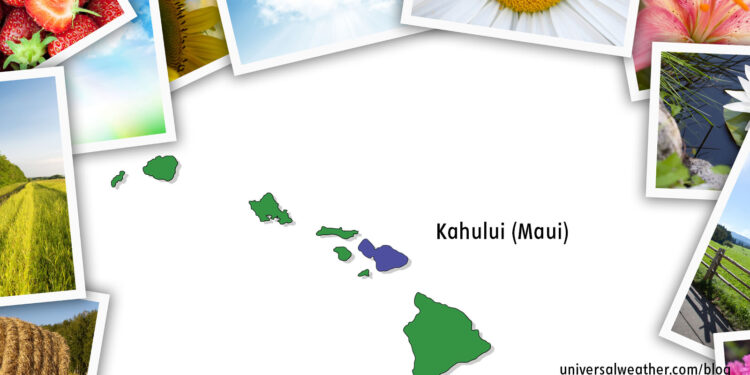Top Operating Considerations for Kahului Maui (PHOG)

This business aviation blog post is part of a series on operating to Hawaii and continues from our last article: “Top Considerations for Business Jet Operations to Honolulu.”
Kahului Maui (PHOG) is an easy and welcoming location for business aircraft as both destination and tech stop, with full services and plenty of aircraft parking available.
The following is an overview of what you need to know when operating to PHOG:
1. Plenty of airport parking is available – even during high season
Aircraft parking for General Aviation (GA) is located next to each Fixed-Base Operator (FBO), and there’s plenty of availability. Busiest period at this location is the November-March high season. During this period it’s best to notify your FBO of all service requests prior to arrival. Note that hotel availability during this busy period is limited, and crew room costs can exceed 300-400 USD per night. There are operators who book crew rooms six months in advance to ensure they get the rooms they want.
2. Not all services are 24 hours
While PHOG is a 24-hour airport, the control tower is normally staffed 0700-2300 local during summer and 0700-2200 local in winter. Normal Customs, Immigration, and Quarantine (CIQ) hours are Monday-Friday, 0700-1530 local, and closed on weekends. International activity to this airport must be advised of in advance. Any weekend or Monday morning international arrivals must have landing approved by Customs prior to takeoff, or the aircraft will not be able to operate into Maui.
3. Overtime is available for CIQ
CIQ overtime is available 24/7 with prior notification. It’s recommended that you provide at least 24 hours’ advance notice for any after-hours clearance. The Customs office is located on the commercial side of the airport, and Customs officers at this location also act as immigration/agriculture officers. Customs clearance is done planeside, and luggage may be inspected at the officer’s request. Always provide an update to Customs if you anticipate a delay in estimated time of arrival – especially if you’re operating after normal hours. There’s no additional charge for after-hours clearance at PHOG.
4. Be aware of agriculture regulations
When you arrive in the Hawaiian Islands, all open onboard catering must be removed from the aircraft and disposed of. Food items that are properly packaged and sealed may remain onboard at the United States Department of Agriculture (USDA) officer’s discretion. For any departure to the U.S. mainland, a USDA agent will meet the aircraft one hour before the aircraft departs. The only fresh produce you may take on the aircraft with you is produce from a USDA-licensed caterer. Cooked items may come from any source; however, all raw produce must be from a licensed source. Note that if you’re departing for a non-U.S. mainland destination, there is no requirement for a USDA inspection, and there are no limitations on fresh produce.
5. Charter operator considerations
As long as charter operators have submitted complete information, including Advanced Passenger Information System (APIS) notification, in advance, your FBO will be able to obtain a stamped/approved gen dec for your aircraft. This allows you to depart the island without having Customs present for departure. A stamped gen dec is valid for 72 hours.
6. Consider catering limitations
It’s best to provide a minimum 24 hours’ advance notice (48 hours is preferred) for any catering request. Many stores on the island close at night, and short-notice catering requests – particularly involving special items – may not be possible. There are two in-flight caterers available at PHOG, and both are licensed by USDA. These are the only sources from which you may obtain raw produce for flights to the U.S. mainland. When you source catering directly from a restaurant or hotel, the catering will go through a security checkpoint, and a USDA agent will inspect the order. It’s important to have any restaurant/hotel catering packaged and cooled correctly prior to delivery. We see many cases of spoiled catering delivered to an FBO, and this can be a food safety issue.
7. Be mindful of airport considerations
FBOs at PHOG have their own fuel trucks to service GA. There is a fuel farm located close to the FBOs, and there are seldom delays in fuel uplifts. Tech stops at PHOG can usually be accomplished in 30-40 minutes, depending on fuel volume requested. FBOs stock common towbars, but it’s always best to check in advance to confirm there is one for your aircraft. While most parking spots at PHOG are power in/power out at the airport, towing may be necessary during busy periods. Peak hours of commercial activity at this airport are usually 1100-1400 local. This location has no operating curfews, no noise restrictions, and no requirement for airport slots or prior permission required. Crew members should take full advantage of a PHOG stop.
8. Hotels and local area
Aside from the many fine hotels, beaches, and restaurants on Maui, there are a number of local attractions to consider. A drive to the top of the inactive volcano Haleakala for a beautiful sunrise is worthwhile, as is a visit to the small town of Hana on the east side of the island. Depending on the time of year, there may also be whale watching opportunities, the annual Maui Film Festival, and assorted hula competitions.
Conclusion
Always notify your FBO in advance of travel to this location. Be aware of high season, and limited hotel options, that may coincide with your planned schedule. Be sure to provide appropriate notification for after-hours CIQ clearance, and be aware of agricultural restrictions at this location.
Later, we’ll discuss operating considerations for travel to Lanai.
Questions?
If you have any questions about this article, contact Christine Vamvakas at christinevamvakas@univ-wea.com.




